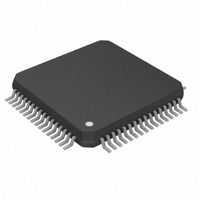DS26521L+ Maxim Integrated Products, DS26521L+ Datasheet - Page 60

DS26521L+
Manufacturer Part Number
DS26521L+
Description
IC TXRX T1/E1/J1 64-LQFP
Manufacturer
Maxim Integrated Products
Type
Line Interface Units (LIUs)r
Datasheet
1.DS26521LN.pdf
(258 pages)
Specifications of DS26521L+
Number Of Drivers/receivers
1/1
Protocol
T1/E1/J1
Voltage - Supply
3.135 V ~ 3.465 V
Mounting Type
Surface Mount
Package / Case
64-LQFP
Product
Framer
Number Of Transceivers
1
Data Rate
44.736 Mbps
Supply Voltage (max)
3.465 V
Supply Voltage (min)
3.135 V
Supply Current (max)
220 mA
Maximum Operating Temperature
+ 85 C
Minimum Operating Temperature
- 40 C
Mounting Style
SMD/SMT
Lead Free Status / RoHS Status
Lead free / RoHS Compliant
- Current page: 60 of 258
- Download datasheet (2Mb)
8.9.16 T1 Programmable In-Band Loop Code Detection
The DS26521 can generate and detect a repeating bit pattern from one to eight bits or 16 bits in length. This
function is available only in T1 mode.
Table 8-26. Registers Related to T1 In-Band Loop Code Detection
Receive In-Band Code Control Register
(T1RIBCC)
Receive Up Code Definition Register 1
(T1RUPCD1)
Receive Up Code Definition Register 2
(T1RUPCD2)
Receive Down Code Definition Register 1
(T1RDNCD1)
Receive Down Code Definition Register 2
(T1RDNCD2)
Receive Spare Code Register 1 (T1RSCD1)
Receive Spare Code Register 2 (T1RSCD2)
Receive Real-Time Status Register 3 (RRTS3)
Receive Latched Status Register 3 (RLS3)
Receive Interrupt Mask Register 3 (RIM3)
The framer has three programmable pattern detectors. Typically, two of the detectors are used for “loop-up” and
“loop-down” code detection. The user programs the codes to be detected in the Receive Up Code Definition
registers
T1RDNCD2). The length of each pattern is selected via the Receive In-Band Code Control register (T1RIBCC).
There is a third detector (Spare) and it is defined and controlled via the
registers. When detecting a 16-bit pattern, both receive code definition registers are used together to form a 16-bit
register. For 8-bit patterns, both receive code definition registers are filled with the same value. Detection of a 1-,
2-, 3-, 4-, 5-, 6-, and 7-bit pattern only requires the first receive code definition register to be filled. The framer
detects repeating pattern codes in both framed and unframed circumstances with bit-error rates as high as 10E-2.
The detectors can handle both F-bit inserted and F-bit overwrite patterns. Writing the least significant byte of the
receive code definition register resets the integration period for that detector. The code detector has a nominal
integration period of 48ms. Thus, after about 48ms of receiving a valid code, the proper status bit (LUP, LDN, and
LSP) is set to 1. Note that real-time status bits, as well as latched set and clear bits, are available for LUP, LDN,
and LSP
software poll the framer every 50ms to 100ms until 5 seconds has elapsed to ensure that the code is continuously
present.
(T1RUPCD1
(RRTS3
REGISTER
and RLS3). Normally codes are sent for a period of 5 seconds. It is recommended that the
and T1RUPCD2) and the Receive Down Code Definition registers
60 of 258
ADDRESSES
FRAMER
0ACh
0ADh
0AEh
0AFh
09Ch
09Dh
0B2h
0A2h
082h
092h
Used for selecting length of receive in-
band loop code register.
Receive up code definition register 1.
Receive up code definition register 2.
Receive down code definition register 1.
Receive up code definition register 2.
Receive spare code register 1.
Receive spare code register 2.
Real-time loop code detect.
Latched loop code detect bits.
Mask for latched loop code detect bits.
DS26521 Single T1/E1/J1 Transceiver
T1RSCD1/T1RSCD2
FUNCTION
(T1RDNCD1
and
T1RSCC
and
Related parts for DS26521L+
Image
Part Number
Description
Manufacturer
Datasheet
Request
R

Part Number:
Description:
MAX7528KCWPMaxim Integrated Products [CMOS Dual 8-Bit Buffered Multiplying DACs]
Manufacturer:
Maxim Integrated Products
Datasheet:

Part Number:
Description:
Single +5V, fully integrated, 1.25Gbps laser diode driver.
Manufacturer:
Maxim Integrated Products
Datasheet:

Part Number:
Description:
Single +5V, fully integrated, 155Mbps laser diode driver.
Manufacturer:
Maxim Integrated Products
Datasheet:

Part Number:
Description:
VRD11/VRD10, K8 Rev F 2/3/4-Phase PWM Controllers with Integrated Dual MOSFET Drivers
Manufacturer:
Maxim Integrated Products
Datasheet:

Part Number:
Description:
Highly Integrated Level 2 SMBus Battery Chargers
Manufacturer:
Maxim Integrated Products
Datasheet:

Part Number:
Description:
Current Monitor and Accumulator with Integrated Sense Resistor; ; Temperature Range: -40°C to +85°C
Manufacturer:
Maxim Integrated Products

Part Number:
Description:
TSSOP 14/A°/RS-485 Transceivers with Integrated 100O/120O Termination Resis
Manufacturer:
Maxim Integrated Products

Part Number:
Description:
TSSOP 14/A°/RS-485 Transceivers with Integrated 100O/120O Termination Resis
Manufacturer:
Maxim Integrated Products

Part Number:
Description:
QFN 16/A°/AC-DC and DC-DC Peak-Current-Mode Converters with Integrated Step
Manufacturer:
Maxim Integrated Products

Part Number:
Description:
TDFN/A/65V, 1A, 600KHZ, SYNCHRONOUS STEP-DOWN REGULATOR WITH INTEGRATED SWI
Manufacturer:
Maxim Integrated Products

Part Number:
Description:
Integrated Temperature Controller f
Manufacturer:
Maxim Integrated Products

Part Number:
Description:
SOT23-6/I°/45MHz to 650MHz, Integrated IF VCOs with Differential Output
Manufacturer:
Maxim Integrated Products

Part Number:
Description:
SOT23-6/I°/45MHz to 650MHz, Integrated IF VCOs with Differential Output
Manufacturer:
Maxim Integrated Products

Part Number:
Description:
EVALUATION KIT/2.4GHZ TO 2.5GHZ 802.11G/B RF TRANSCEIVER WITH INTEGRATED PA
Manufacturer:
Maxim Integrated Products

Part Number:
Description:
QFN/E/DUAL PCIE/SATA HIGH SPEED SWITCH WITH INTEGRATED BIAS RESISTOR
Manufacturer:
Maxim Integrated Products
Datasheet:










